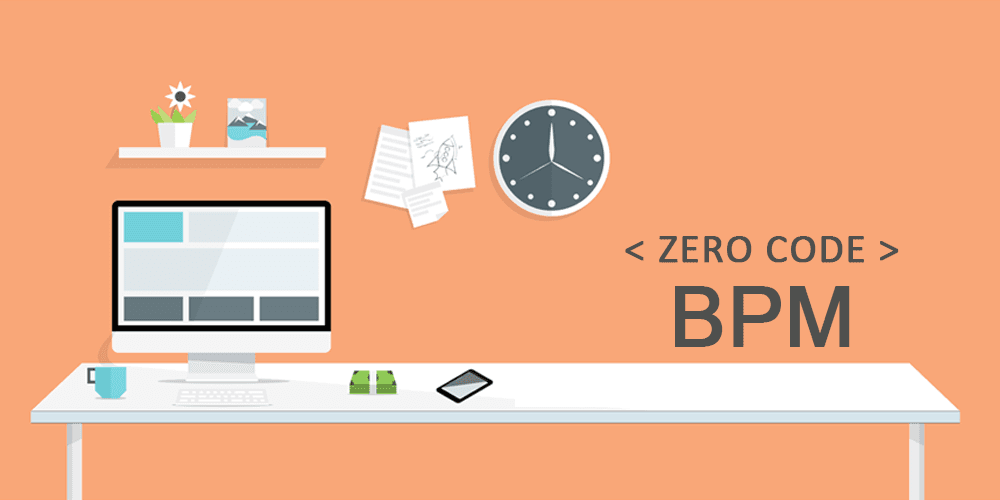Empower Your Employees Low Code BPM to Enhance Workflow

Key takeaways
- Low-code BPM platforms are developed with a visual user interface and drag-and-drop features that automate specific aspects of the development process minimizing coding.
- Crucial features of low-code BPM tools include integrations, drag-and-drop visibility, and electronic document management.
- Low-code BPM is easier to implement, is time efficient, easier to create new templates for workflows, has low operating costs, greater standardization, and better compliance and risk management.
Table of Contents
Organizations are increasingly adopting BPM technologies with the rapid digital transformation worldwide to meet aggressive business goals. Business process management facilitates organizations to become more agile and improve their process efficiency.
The global market for low code development technologies in 2021 was $13.8 billion which is expected to increase by 70% by 2025 as Gartner predicts.
As low-code BPM continues to grow, it improves business productivity allowing for more innovation. Therefore to stay competitive your business must adopt low-code technology.
What is a Low-code BPM?
The low-code platforms are software used for optimizing an organization’s Business Process Management strategies. These are developed using low-code development, a software development method, using which software is developed using minimal codes. Hence, addressed as low-code development. A low-code BPM can offer more flexibility and standardization to all the business operations in an organization.
When low-code BPM software is implemented into an organization’s system, all the business processes are made simpler with just a drag-and-drop action involving a simple and minimal usage of manual coding. Some important pointers to know about low-code are as follows:
- Using a low-code software tool promises the users complete control over the business processes, and also an environment where solutions can be built using this visual interface.
- Low-code software is the best choice for building apps and automating different business processes and workflows.
- Additionally, a low-code software comes with the features of integrating it with other external applications thus enhancing the viability of the operations.
Crucial Features in a BPM Low-code Platform
When organizations are looking for a low-code BPM platform, three factors have to be prioritized to elevate the performance of the business processes. These parameters are as follows:
Integrations
When integration is not offered by a low-code BPM software the performance results in data silos and inefficient processes. Third-party application integration is highly crucial for consistent and error-free processes. It must also support API endpoints that would make the integration possible.
Drag-and-drop Usability
It is essential to understand the built-in modules in a low-code platform. The navigation within the tool is easier making it simpler for Line of Business users who have minimal knowledge of coding. The simple drag-and-drop functionality can make the utility simple for the users.
Electronic Document Management
A low-code BPM platform replaces the use of paper-based documents. It offers the solution of electronic document management, where electronic documents can be maintained and stored on the cloud. This way the users have streamlined processes with secured data access through cloud storage. The BPM software provides a simple automation that matches the right documents with the right process.
Here are the Top 6 Reasons Why Low Code BPM is Essential for Your Business.
1. No-Code Facilitates Easier Implementation
Implementing a no-code program is much easier because it will not intimidate your employees as software-based real-time coding would do.
Even the lowest requirement to code will prevent a lot of people from getting on board willingly. The attitude, in turn, will affect your business productivity and it becomes impossible to implement workflow automation in your office environment.
Low-code business process management makes it possible and will encourage all your employees to adopt it without any hesitation.
2. Time Efficient with No Training Phase
There is no need to spend time training your workforce on different aspects of a no-code business process software.
The entire system is based on a visual user interface with simple instructions. All they have to do is fill up the predefined columns when requesting leaves, invoices to be approved and files to be verified by the senior management. An employee can upload a document and it will automatically be forwarded to his or her respective manager for approval. The convenience of not having dedicated training hours for your people is something that you will appreciate when the software is implemented in a matter of hours and is used by every team.
End-to-end workflow automation
Build fully-customizable, no code process workflows in a jiffy.
3. Simplest Way to Create New Templates
The Low Code BPM does come with a large collection of widely used templates for the HR department, the finance people, and operations. It also includes leave request and approval templates but there are always specific business requirements.
When your employee has a specific requirement, they don’t have to seek help from the development team. They can instantly create new templates based on their requirement and encourage their teammates to start using them. Being a no-code application, it’s easier to create new business-specific workflow modules that you can immediately start using.
4. Lower Operating Costs
Most businesses are put in a dilemma where they have to choose to buy or build process improvement applications. Leveraging a low-code BPM software allows lower operating costs compared to a manually-operated setup or building an application. Users have the option to test and rule out any upgrades in the application based on operating costs. This allows users to monitor and control tech sprawl and receive upgrades via a single platform.
5. Greater Standardization Across Processes
Achieving standardization across all business operations is not an easy task where efficiency and consistency have to be simultaneously taken care of. This is where a low-code BPM stands out. The striking quality of low-code software is that it is user-friendly and can be customized to the needs of every department. This way standardization is made simpler and accommodating new upgrades is also made seamless and can be easily rolled out.
6. Better Compliance and Risk Management
This type of software development is effective, especially in the case of catering to the changing regulations and end customer expectations. In such an environment, this approach supports modifications that can be effortlessly made to the changing requirements. How is this done? Here is how:
- By streamlining and optimizing business processes by adhering to the new regulations instantly.
- By eliminating any threatful shadow IT operations.
- By determining the accessibility and controls for the users.
Challenges In BPM
Even if you choose the right solution for your organization, no solution can be implemented without any challenges. Moreover, being prepared to adapt and be responsive to these challenges is highly crucial. These challenges can cost customer satisfaction and retention. Therefore, here is an insight into some of the commonly found challenges during the implementation of a BPM solution.
1. Too Many Solutions
Many organizations use multiple solutions which can create problems in the flow of processes. This might result in a disjointed outcome that has caused a waste of time and other resources for the organization.
2. Siloed Teams
Department-based customizations can sometimes lead to siloed teams. It can result in disharmony in communication, collaboration initiatives, productivity, etc. Therefore, updates, flow of information/data, and exchange of product details can all be interrupted.
3. Too Much Data Visibility
Real-time visibility is an important feature that BPM low-code offers. Sometimes without a defined access and control setup, can offer too much visibility into the processes. Most often more data can cause misunderstandings and lead to haste decisions. Therefore, boundaries have to be set with data visibility.
4. Poor Buy-in
It is important to understand that implementing a BPM solution might seem like it can solve any problem, but it is not the case. The solution is a huge help in managing all the processes but is not a one-click solution. However, the point to note is that these can be upgraded to meet any needs.
Take the next step with Cflow’s Low-code BPM
Cflow is one of the best Low Code BPM solutions that you could find which comes with a set of predefined templates to get you going instantly. Using our AI-powered workflow software is an intuitive process for which your employees need no coding knowledge.
While we already provide you with all essential workflow templates to automate your process, the no-code BPM makes it easier to implement new software in your organization. It’s easy to use, simplified visual UI, and doesn’t require any training.
Give Cflow a try and you will be able to see how it can revolutionize the way your employees work by being a unified platform to get all their everyday tasks done more efficiently.
What should you do next?
Thanks for reading till the end. Here are 3 ways we can help you automate your business:

Do better workflow automation with Cflow
Create workflows with multiple steps, parallel reviewals. auto approvals, public forms, etc. to save time and cost.

Talk to a workflow expert
Get a 30-min. free consultation with our Workflow expert to optimize your daily tasks.

Get smarter with our workflow resources
Explore our workflow automation blogs, ebooks, and other resources to master workflow automation.

